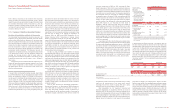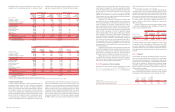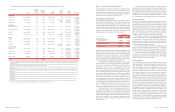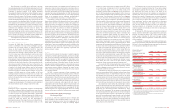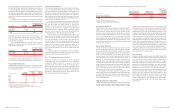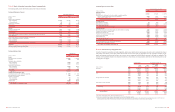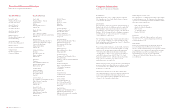Bank of America 2003 Annual Report Download - page 51
Download and view the complete annual report
Please find page 51 of the 2003 Bank of America annual report below. You can navigate through the pages in the report by either clicking on the pages listed below, or by using the keyword search tool below to find specific information within the annual report.
The Corporation also sells products that guarantee the return of
principal to investors at a preset future date. These guarantees cover
a broad range of underlying asset classes and are designed to cover
the shortfall between the market value of the underlying portfolio and
the principal amount on the preset future date. To manage its expo-
sure, the Corporation requires that these guarantees be backed by
structural and investment constraints and certain pre-defined triggers
that would require the underlying assets or portfolio to be liquidated
and invested in zero-coupon bonds that mature at the preset future
date. The Corporation is required to fund any shortfall at the preset
future date between the proceeds of the liquidated assets and the pur-
chase price of the zero-coupon bonds. These guarantees are booked
as derivatives and marked to market in the trading portfolio. At
December 31, 2003 and 2002, the notional amount of these guaran-
tees totaled $7.4 billion and $4.1 billion, respectively; however, as of
December 31, 2003 and 2002, the Corporation had not made a pay-
ment under these products, and management believes that the proba-
bility of payments under these guarantees is remote. These guarantees
have an approximate term ending between 2005 and 2010.
In the ordinary course of business, the Corporation enters into
various agreements that contain indemnifications, such as tax indem-
nifications, whereupon payment may become due if certain external
events occur, such as a change in tax law. These agreements typically
contain an early termination clause that permits the Corporation to
exit the agreement upon these events. The maximum potential future
payment under indemnification agreements is difficult to assess for
several reasons, including the inability to predict future changes in
tax and other laws, the difficulty in determining how such laws would
apply to parties in contracts, the absence of exposure limits con-
tained in standard contract language and the timing of the early ter-
mination clause. Historically, any payments made under these
guarantees have been de minimis. Management has assessed the
probability of making such payments in the future as remote.
The Corporation has entered into additional guarantee agree-
ments, including lease end obligation agreements, partial credit guar-
antees on certain leases, sold risk participation swaps and sold put
options that require gross settlement. The maximum potential future
payment under these agreements was approximately $1.3 billion and
$575 million at December 31, 2003 and 2002, respectively. The esti-
mated maturity dates of these obligations are between 2004 and
2025. As of December 31, 2003 and 2002, the Corporation had
made no material payments under these products.
For additional information on recourse obligations related to
mortgage loans sold and other guarantees related to securitizations,
see Note 9 of the consolidated financial statements.
Litigation and Regulatory Matters
In the ordinary course of business, the Corporation and its subsidiaries
are routinely defendants in or parties to a number of pending and
threatened legal actions and proceedings, including actions brought on
behalf of various classes of claimants. In certain of these actions and
proceedings, claims for substantial monetary damages are asserted
against the Corporation and its subsidiaries and certain of these
actions and proceedings are based on alleged violations of consumer
protection, securities, environmental, banking and other laws.
In view of the inherent difficulty of predicting the outcome of
such matters, the Corporation cannot state what the eventual out-
come of pending matters will be; however, based on current knowl-
edge, management does not believe that liabilities, if any, arising
from pending litigation or regulatory matters, including the litigation
and regulatory matters described below, will have a material adverse
effect on the consolidated financial position or liquidity of the
Corporation but may be material to the Corporation’s operating
results for any particular quarter.
Mutual Fund Ope rations
On September 3, 2003, the Office of the Attorney General for the
State of New York (NYAG) simultaneously filed and settled a com-
plaint against Canary Capital Partners, LLC, et al. (collectively,
Canary). The complaint alleged, among other things, that Canary
engaged in improper trading with certain mutual funds in the Nations
Funds family (Nations Funds). Specifically, the NYAG alleged that
Canary engaged in activities that it characterized as “market timing”
and “late trading.” The Corporation is cooperating fully with the NYAG,
the SEC and other regulators in connection with these inquiries.
On September 16, 2003, the NYAG announced a criminal
action, and the SEC announced a civil action, against a former
employee of Banc of America Securities LLC (BAS). The complaints
allege that this former employee played a key role in enabling Canary
to engage in “late trading” of shares of Nations Funds and other
mutual funds in violation of state and federal law.
The Corporation has announced that it will establish a restitution
fund for shareholders of the Nations Funds who were harmed by
Canary’s late trading and market timing practices. In addition, the
Corporation announced that it will provide restitution for shareholders
of third party mutual funds who were harmed by any late trading activi-
ties by Canary that are found to have occurred through the Corporation
in the event restitution is not otherwise available from Canary, its affil-
iates, its investors or from any other third parties. The Corporation has
also committed to return to the Nations Funds all funds management
and advisory fees related to the Canary market timing agreement.
The Corporation has named several key leaders and advisors
external to the Corporation to review mutual fund practices. These
individuals are currently leading an independent review of the
Corporation’s mutual fund policies and practices, including a com-
plete legal and regulatory compliance review of the Corporation’s
mutual fund business, and coordinating a detailed review of all tech-
nology, control, and compliance systems related to the mutual fund
business, including all systems relating to sales, clearing, and deriv-
ative and brokerage operations.
The Corporation is developing new policies to eliminate all lend-
ing, derivatives, brokerage services or any other services relating to
mutual fund trading activity by clients known to the Corporation to
engage in active mutual fund market timing not permitted by the tar-
geted funds. The Corporation has committed that the market timing
policies being established will no longer permit special exceptions.
The independent trustees of the Board of Trustees of the
Nations Funds have retained an independent firm to evaluate the
extent of any adverse monetary impact to any Nations Fund in which
the Nations Funds’ adviser permitted a discretionary market timing
agreement. They also announced that they would evaluate whether
any additional steps are appropriate to assure Nations Funds share-
holders that the Nations Funds are being managed in their best inter-
ests. In addition, the independent trustees announced that the Board
of Trustees, with the assistance of the independent firm, will conduct
a review of the issues relating to late trading in Nations Funds, con-
sider the results of the review of these issues being conducted by the
Corporation, and take action as appropriate.
As of the date hereof, a number of lawsuits and regulatory pro-
ceedings have been filed against the Corporation, its affiliates and
associates in connection with these circumstances, alleging, among
other things, breaches of fiduciary duties, federal securities laws, the
ERISA Act, the Investment Company Act of 1940, and the Investment
Advisers Act of 1940 as well as contractual and other common law
claims. The Corporation has also received shareholder derivative
actions purportedly brought on behalf of the Corporation alleging var-
ious claims, including breach of fiduciary duty, against the Board of
Directors in connection with these matters. Additional lawsuits or reg-
ulatory proceedings presenting similar or additional allegations and
requests for relief arising out of these circumstances could be filed
in the future against the Corporation and related parties.
During the quarter ended September 30, 2003, the Corporation
recognized a $100 million charge to income in connection with these
matters. The Corporation, however, cannot determine at this time the
eventual outcome, timing or impact of these matters. Accordingly, it
is possible that additional charges in the future may be required.
Enron Corporation (Enron) Se curitie s Litigation
The Corporation was named as a defendant, along with a number of
commercial and investment banks and their holding companies, cer-
tain former Enron officers and directors, law firms and accountants,
in a putative consolidated class action pending in the United States
District Court for the Southern District of Texas filed on April 8, 2002
entitled Newby v. Enron. The amended complaint, which was filed in
May 2003 and is now the operative complaint, alleges claims against
the Corporation and BAS under Sections 11, 12 and 15 of the
Securities Act of 1933 related to the role of BAS as an underwriter of
two public offerings of Enron debt and as an initial purchaser in a pri-
vate placement of debt issued by an Enron-affiliated company. The
Corporation and BAS have moved to dismiss all of the claims
asserted against them in the operative complaint. That motion is fully
briefed and remains pending. Plaintiffs’ motion for class certification
is fully briefed and remains pending.
In addition, the Corporation and certain of its affiliates have
been named as defendants or third-party defendants, along with
other commercial and investment banks and many other parties, in
various other individual and putative class actions relating to Enron.
The complaints assert claims under federal securities laws, state
securities laws and/or state common law or statutes. The majority of
these actions were either filed in or have been transferred to the
United States District Court for the Southern District of Texas and
consolidated or coordinated with Newby v. Enron.
The Corporation cannot determine at this time the eventual out-
come, timing or impact of these matters.
WorldCom, Inc. (WorldCom) Se curities Litigation
BAS, Banc of America Securities Limited (BASL), and other underwrit-
ers of WorldCom bonds issued in 2000 and 2001, as well as former
officers and directors of WorldCom and other parties, have been
named as defendants in a class action lawsuit filed in the United
States District Court for the Southern District of New York entitled
WorldCom Securities Litigation. The operative complaint alleges
claims against BAS and BASL under Sections 11 and 12 of the
Securities Act of 1933 in connection with 2000 and 2001 public bond
offerings and is brought on behalf of purchasers and acquirers of
bonds issued in or traceable to these offerings. On October 24, 2003,
United States District Court Judge Denise Cote certified a class
consisting of “all persons and entities who purchased or otherwise
acquired publicly-traded securities of WorldCom during the period
beginning April 29, 1999 through and including June 25, 2002 and
who were injured thereby.” Fact discovery is presently proceeding in
this class action and a trial date has been set for January 10, 2005.
In addition, the Corporation, BAS and BASL, along with other
underwriters, certain holding companies affiliated with the underwrit-
ers, a former Salomon Smith Barney telecommunications analyst,
certain former officers and directors of WorldCom and WorldCom’s
former auditors have been named as defendants in numerous indi-
vidual actions that were filed in either federal or state courts arising
out of alleged accounting irregularities of the books and records of
WorldCom. Plaintiffs in these actions are typically institutional
investors, including state pension funds, who allegedly purchased
debt securities issued by WorldCom pursuant to public offerings in
1997, 1998, 2000 or 2001. The majority of the complaints assert
only claims under Section 11 of the Securities Act of 1933, but some
complaints also include claims under the Exchange Act of 1934,
state securities laws, other state statutes and under common law
theories. Most of these cases were filed in state court and subse-
quently removed (as related to WorldCom’s bankruptcy) by defen-
dants to federal courts and then transferred by the Judicial Panel for
Multidistrict Litigation to the United States District Court for the
Southern District of New York to be consolidated with WorldCom
Securities Litigation for pre-trial purposes. Seven of these actions,
which have been removed, were remanded to state courts in Alabama
(2), Tennessee, Pennsylvania (3) and Illinois.
Certain plaintiffs in actions transferred to the Southern District
of New York have filed an appeal to the Second Circuit Court of
Appeals arguing that their actions were not properly removed to fed-
eral court because a provision in the Securities Act prevented such
removals. Defendants, including the underwriters, have argued that
removal was proper.
Additional complaints were filed on behalf of purchasers of
WorldCom stock in state courts in Mississippi against the
Corporation and BAS, as well as certain former officers and directors
of WorldCom, other commercial and investment banks and other par-
ties. These cases have also been transferred to the United States
District Court for the Southern District of New York and consolidated
with WorldCom Securities Litigation for pre-trial purposes.
The Corporation cannot determine at this time the eventual out-
come, timing or impact of these matters.
Ade lphia Communications Corpo ration (Ade lphia) Se curitie s Litigation
Bank of America, N.A. and BAS are defendants in several private civil
actions relating to Adelphia which have been consolidated for pre-trial
purposes and are currently pending in the United States District
Court for the Southern District of New York. The actions include a
class action and various individual actions. BAS was a member of
seven underwriting syndicates of securities issued by Adelphia, and
Bank of America, N.A. was an agent and/or lender in connection with
five credit facilities in which Adelphia subsidiaries were borrowers.
Additional defendants include other members of those syndicates,
underwriters for additional Adelphia securities offerings, lenders and
agents for that and other credit facilities, former Adelphia insiders
and members of its board of directors, and Adelphia's outside
auditors and counsel. The complaints allege claims under the
Securities Act of 1933 and the Securities Exchange Act of 1934.
98 BANK OF AMERICA 2003 BANK OF AMERICA 2003 99


